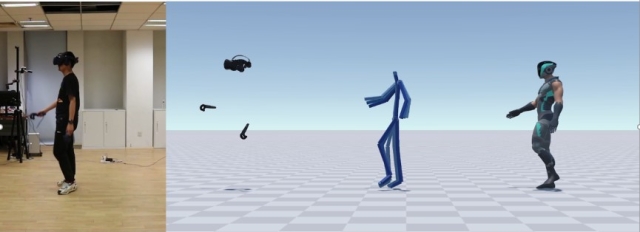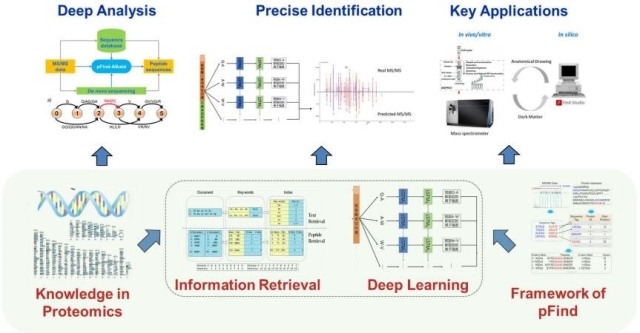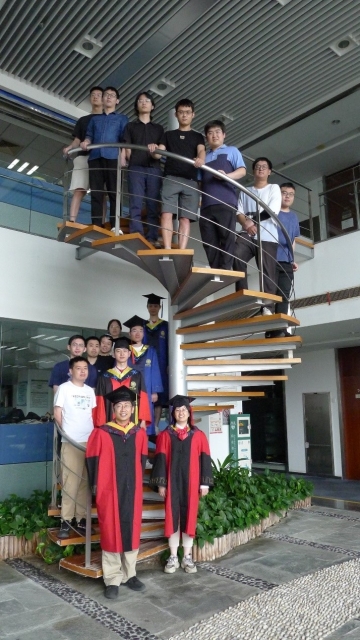- The Prospective Research Laboratory, founded in 2005, provides fundamental and prospective research in computer science and technology and related interdisciplinary fields, and takes up cooperative projects with research teams around the world to promote sustainable IT development and interdisciplinary research. Establishing a talent foundation for long-term development within the Institute of Computing Technology (ICT, CAS) is its additional mission.
- The laboratory operates as an open organization with flexible teams, fair competition, excellence-preferential support, and encouragement of innovation. While creating an atmosphere of innovation, truth-seeking, efficiency and harmony, the laboratory advocates the ideals of being first, being the pioneer, and being failure-tolerant in innovative research. The team, as it builds the laboratory into a source of excellent talents, creates a best-fit place for fundamental and prospective computing technology research.
- An explorer of prospective science and technology and incubator of new application technologies, Prospective Research Laboratory now consists of eight research groups under the umbrella of the Chinese Academy of Sciences. These are: Agricultural Intelligent Technology Laboratory (Intelligent Agricultural Machinery Equipment Engineering Laboratory of CAS), Media Synthesis and Forensics Laboratory, Laboratory for Quantum Computation and Theoretical Computer Science, Big Data Supervision Research Group, Human Motion Modeling Research Group, Bioinformatics Glycoprotein Structure Research Group, Bioinformatics pFind Research Group, and Virtual Reality Research Group.
- Agricultural Intelligent Technology Laboratory
- The Agricultural Intelligent Technology Laboratory, an interdisciplinary team created by ICT, relies on the institute’s disciplinary advantages in intelligent technology to find tech solutions for the strategic, in-common needs of national agricultural production. A team mission is building China’s smart agriculture 1.0 to strengthen national food security. Based on Big Data and AI , the laboratory takes intelligent agricultural machinery and agricultural intelligent systems as the fulcrum, and regards China’s agricultural intelligent solutions as its goal, with an emphasis on accurate simulation, accurate prediction and independent implementation of agricultural production processes. The laboratory undertakes national, provincial and ministerial projects. These have included projects mandated by China’s key R&D plan, and a leading A-project of the Academy of Sciences with research funds of more than RMB100 million. Two provincial and ministerial key laboratory platforms have been built: Key Laboratory of Agricultural Machinery Operation Monitoring and Big Data Application of the Ministry of Agriculture and Rural Affairs; and the CAS Intelligent Agricultural Machinery Engineering Laboratory.
- The Agricultural Intelligent Technology Laboratory already has some technical breakthroughs including its R&D of the “Honghu” new-energy intelligent network tractor, which uses intelligent networking and can operate unmanned. Honghu T300 holds the largest horsepower record among China’s new energy farm tractors, as explained in a CCTV special report. Linked to agricultural Big Data systems, it achieved success with fine data through its four-level plot management. The laboratory has established models and algorithm libraries for various types of soil and crops and for general agronomy. The lab’s “data-driven, agricultural machinery execution” for the national agricultural production framework won the gold medal at the 2022 World Internet of Things Expo. It was first placed into operation in Hulunbuir Agricultural Reclamation Group and has been used by Guangxi Agricultural Investment Group and other large state-owned agricultural enterprises. Tens of millions of mu of agricultural production area in China will see its socioeconomic benefits.
CIT’s Agricultural Intelligent Technology Laboratory won gold at the 2022 World of IoT
- Laboratory for Quantum Computation and Theoretical Computer Science
- The Laboratory for Quantum Computation and Theoretical Computer Science (formerly Algorithm and Complexity Group) is part of the Advanced Computer Research Center of the Institute of Computing Technology, Chinese Academy of Sciences (ICT, CAS). The laboratory researches quantum computing and classical algorithm theory. In the field of quantum computing, the lab team mainly focuses on quantum search and optimization algorithm, quantum machine learning, quantum random walk, quantum circuit optimization and mapping, variable quantum algorithms, and quantum computing complexity. We are committed to using quantum computing’s features to solve combinatorial optimization problems and machine learning difficulties, to explore quantum chemistry, and to optimize algorithms or circuits according to current quantum computing limits. In the field of classical algorithms, we focus on combinatorial optimization algorithm design, computational complexity theory and algorithmic game theory as we search for algorithms with lower space-time complexity for various computational problems, and explore theoretical limits.
Students and instructors of the Laboratory for Quantum Computation and Theoretical Computer Science
- Media Synthesis and Forensics Laboratory
- The Media Synthesis and Forensics Laboratory (formerly Multimedia Computing Group), established in 2002, undertakes research in accordance with key directions of the ICT, CAS 14th Five-Year Plan. Focusing on basic research and applications of digital content security, the laboratory was among the earliest in China to research online false information detection. To meet national and societal security needs, the laboratory built a three-level depiction of algorithms, systems and applications, developed the first Chinese automatic false news detection system AI Shiyao, and innovated the country’s first forgery detection system optimized with software-hardware collaboration and equipment. Industrial scenarios in public safety, epidemic prevention and control, finance, media and other fields have relied on its findings and achievements. In addition to publishing more than 40 papers in renowned international conferences and journals about NLP, AI, computer vision and multimedia, the team was able to release the largest Chinese multi-modal fake news detection dataset. It also holds competitions to promote the development of the forgery detection field.
- Primary research directions are:
- Detection and verification of multimedia fake news—The focus is on realizing fast, accurate, reliable fake news detection systems from the perspectives of explainability, multi-modality, and multi-domain situations.
- Image and video forgery detection and attribution—The focus is on robust, generalizable deepfake detection and attribution to tackle serious security threats in cyberspace.
- Generation of text, image and video content—The focus is on generation technologies to mitigate malicious forged content and reduce its negative impact.
- Big Data Supervision Research Group
- Researching the newest IT to solve the world-class problem of self-supervision, the group studies the theoretical core of Big Data supervision, explores the technical system of corruption prevention, and seeks to establish a standardized application model so as to promote modernization of China’s governance system and governance capacity.
- Among the group’s achievements thus far is the proposal for a technical application system of Big Data supervision that includes these aspects: summarized and proposed the tetrahedron of corruption causes from a technical viewpoint; summarized and put forward three laws of supervision (necessary rate, method rate, statistical rate); initial breakthrough of power digital twin technology; intelligent modeling of problems, and heterogeneous knowledge integration; established computing frameworks of power, problem and responsibility; and formed standards, specifications and guidelines for data filing, problem analysis, supervision and management. These achievements have been extensively applied in provincial and municipal governments and enterprises, integrating a new infrastructure promoting high-quality anti-corruption work.
- Research directions:
- Power twin technology: The operation of government power in a complex modern system records traces of its power operation in e-government departmental systems, generating exercise data. The research aims to reproduce the power operation process by filing exercise data, power digital twin, extracting and analyzing power data.
- Intelligent extraction technology of policy rules: AI technology analytics is used to find rules from policies, regulations, laws, regulations and other texts to form a rule model for Big Data supervision.
- Problem intelligence analysis technology: Analysis is done through modeling the problems of funds, projects, materials, decision-making and key people, through scanning the exercise loopholes and finding the exercise problems, then analyzing the problem rules and evaluating the technical system of policy risks.
- Human Motion Modeling Group
- Developing novel interactive computing technology useful for the fusion of humans and AI systems is the task of the Human Motion Modeling Group. To explore the newest computational models and methods for simulating or synthesizing natural human movement necessitates a cross-field research approach that includes computer graphics, VR and AI. Motion capture and motion understanding integrated with deep learning, generative models for motion synthesis and motion control, virtual human modeling using digital twins, and applications in augmented reality and humanoid robotics are among the group’s research interests, as demonstrated in the photograph and computer imagery, below.

- Motion capture and virtual human modeling
- Bioinformatics Glycoprotein Structure Group
- The Bioinformatics Glycoprotein Structure Group currently has three individual teams researching the bioinformatics of glycoprotein structure. The GIPS team is researching computational glycomics, the FALCON team is designing related software, and the AIA team is dedicated to machine learning and algorithms.
- GIPS’ research in computational glycomics extends to protein structure prediction and related AI-assisted algorithm design. The GIPS team proposed a Seq-Set Net neural network architecture for protein structure prediction that handles multiple-sequence alignments with sequence order-independence; experimental results show significant improvement to the accuracy of protein structure prediction. An algorithm for heparin mass spectrometry visualization and identification has been developed from its computational glycomics research, and that research is applied to Dongcheng Pharmaceutical’s drug production and quality control. “Bioinformatics” and other specialized journals in the field have published GIPS research.
- The FALCON team developed an intelligent protein design software named ProDESIGN that builds a “wet and dry experimental” closed loop for protein design. The team designed two proteins with stable functions, establishing a basis for protein drug design. The prediction accuracy of the team-designed antibody structure prediction software, AbFold, exceeds the mainstream algorithm and has been put into commercial cooperation. FALCON’s ProFOLD-ZERO single sequence-based protein structure prediction software has prediction accuracy far exceeding mainstream software AlphaFold2, and is innovative for exploring protein folding mechanism and protein design.
- The AIA team has designed machine learning and deep learning algorithms for a series of NP-complete problems such as the minimum weighted coverage problem, the traveling salesman problem, and the mixed integer linear programming problem.
Teams within the Bioinformatics Glycoprotein Structure Group
- The pFind Team
- The pFind Team, a bioinformatics research group in the direction of computational proteomics, focuses on methods and technology development for massive biological mass spectrometry data analysis. Since its inception in 2002, the pFind team has published over 60 research articles in high-level journals such as Nature Biotechnology, Nature Methods, and Nature Communications, including research on their pFind Studio software system. By applying statistical machine learning, pattern recognition and combinatorial optimization, and fully incorporating biological mass spectrometry techniques, the team uses mass spectrometry data to investigate peptides and proteins, aiming to innovate high-level applications for the life sciences and precision medicine.
- The pFind Studio, which is a proteome data analysis software tool the team developed and maintains, has been downloaded more than ten thousand times across six continents, yielding nearly 700 applications, including 49 published in Nature, Science, and Cell. pFind was recognized as one of the top 10 Chinese bioinformatics advances in 2018. “The key technology and applications for deep resolution of massive mass spectrometry data in proteomes,” a process pioneered by the pFind team, earned first prize in 2019 for technological invention from the China Computer Federation (CCF).
-

- Work of the pFind /Team
- VR Research Group
- The Virtual Reality (VR) Research Group concentrates on basic, prospective and cross-cutting research about Virtual Reality and, more specifically, on group behavior modeling, motion simulation, 3D reconstruction and visualization, intelligent perception, and dynamic decision-making. Research from the group has been published by top academic journals and presented at conferences such as TIP, TVCG and ICCV. Special studies were made in the fields of public security, aerospace, and on-screen entertainment. The VR Research Group’s AR content fusion product, Othka digital studio, is used by many television stations, universities, and live broadcast bases.
-

- The work of the Virtual Reality Research Group
downloadFile


